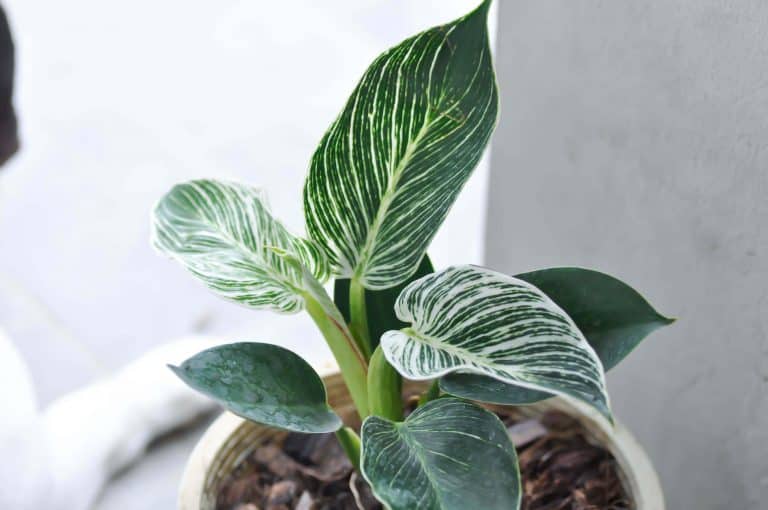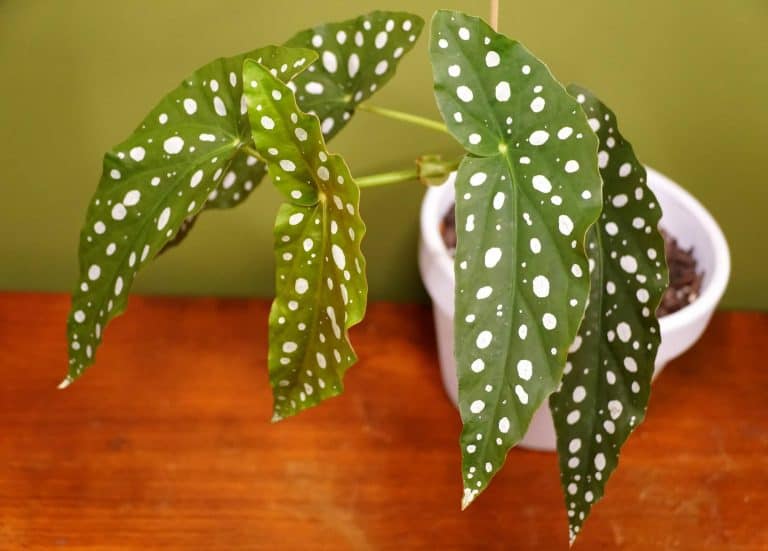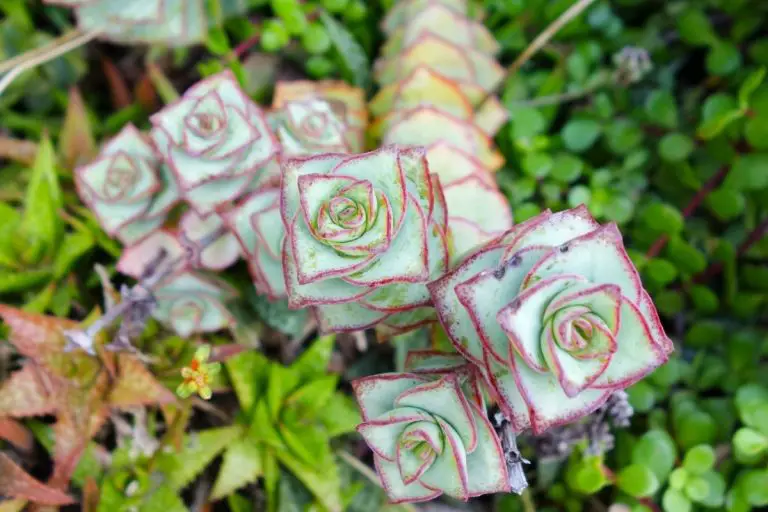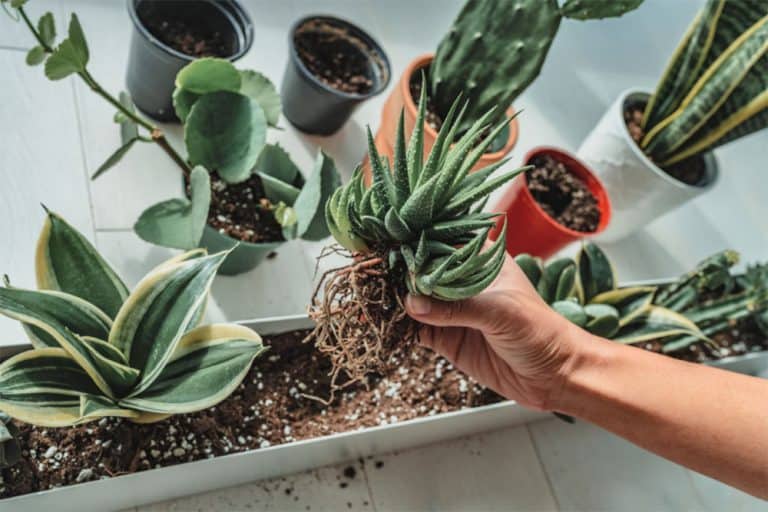Snow Queen Pothos – Easy to Follow, Grow Care Guide
Have you heard plant enthusiasts rave about the Snow Queen Pothos and wanted it as well? Do you already have a Snow Queen Plant and do not know how to care for it?
Do not worry, you are at the right place. As you read on, you will be treated to the most comprehensive guide to owning the Snow Queen Pothos and where to buy it.
Snow Queen Pothos are part of the Pothos plant family. It is very popular as a houseplant because it is so easy to care for it. What makes this plant so distinguishable and attractive is its heart-shaped leaves.
Here Is What We Will Be Covering in This Article:
- What is a Snow Queen Pothos?
- How do you identify a Snow Queen Pothos?
- Is Snow Queen a Pothos?
- How do you care for a Snow Queen Pothos?
- Snow Queen Pothos Propagation Steps
- Is there a difference between Snow Queen Pothos and Marble Queen Pothos
- How much light does the Marble Queen Pothos need
- Best places to buy the Snow Queen Pothos
- Benefits of Snow Queen Pothos
- Common Problems with Snow Queen Pothos
- How to save an unhappy Snow Queen Pothos
- Varieties of Snow Queen Pothos
I did say that this would be comprehensive. Get your green fingers and nature-loving eyes ready, sit back and enjoy the ride.
DISCLAIMER
Some of the links on here are affiliate links and I may earn if you click on them, AT NO EXTRA cost to you. Hope you find the information here useful! Thanks.
Related Articles:
- Philodendron Florida Ghost – The Most Comprehensive Guide
- Philodendron Giganteum – Complete Care Guide
- Crassula Hottentot – Practical Care Guide
- Essential Guide To Philodendron Melanochrysum Care
- How To Get Rid Of Pot Worms [A Quick And Easy Guide 2022]
- Scindapsus Moonlight – Essential Tips You Need to Know
- Jade Satin Scindapsus – Plant Care, Propagation and Remarkable Tips
What Is a Snow Queen Pothos?
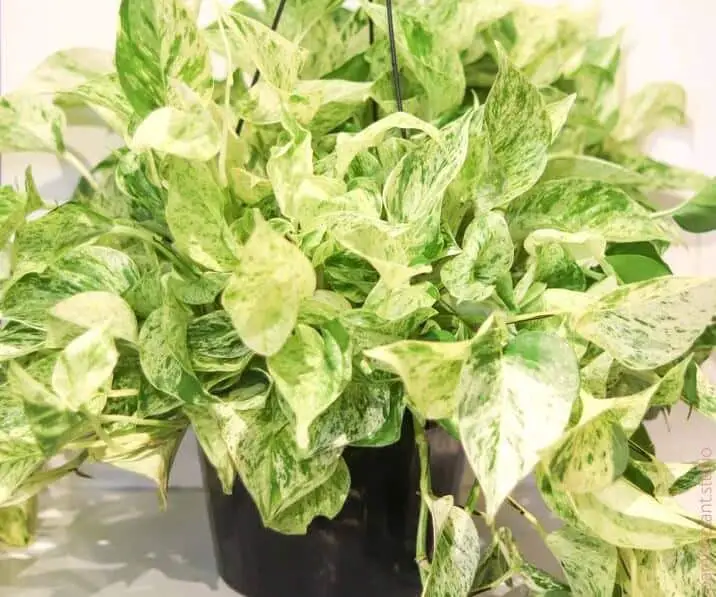
The Pothos Snow Queen is originally from the humid jungles of the Solomon Islands. They enjoy a warm environment. It has heart-shaped leaves which is its most attractive feature.
Each leaf has green and white markings.
This means that the leaves are variegated. Variegated plants mean that the leaves have 2 colours. It can be 2 completely different colours or just 2 separate tones.
Snow Queen Pothos is usually found indoors because it is a strong air-purifier. It has long vines which means it is a climbing plant. You may put a bamboo pole beside it to help it grow tall.
Get your bamboo pole here.
Alternatively, you can also use a Trellis to help it grow tall. A Trellis is a functional and decorative-looking fence that can support your plant as it grows. Get your Trellis here.
Snow Queen Pothos is commonly referred to as a plant that is difficult to kill because it is so hardy. This means that the Snow Queen Pothos is perfect for beginners who are learning to maintain house plants and fear committing botanical murder.
Even though the Snow Queen Pothos is mostly found indoors, you may also plant it outdoors. However, this is only suitable in warmer climates because it cannot take extremely cold temperatures.
The Snow Queen Pothos comes from the Aracea Plant Group. Its Genus is Epipremnum. That is why in some parts of the world, this plant is also referred to as Epipremnum Aureum or Epiprepnum Snow Queen.
Another common name for this is Snow Queen Devil’s Ivy.
The term Genus is used as a way of classifying plants in a group. They have certain similarities, though it is not always so obvious.
How Do You Identify a Snow Queen Pothos?

Snow Queen Pothos have leaves that are much whiter than the Marble Queen Pothos. It was mentioned earlier that their leaves are variegated. As you can see there are strips of green and white on the leaves.
The ratio of white to green on their leaves is estimated to be about 80% to 20%. This makes it a Snow White Pothos. It has beautiful heart-shaped leaves. Due to the large ratio of white on the leaves, it appears more translucent than other Pothos plants.
The leaves are not very smooth. If you touch them, you will find uneven spots and it is a little waxy to touch.
If you wish to learn more about how to identify a Snow Queen Pothos, you may watch this in-depth video. It is a Pothos Identification Guide. You can fast forward to 9 minutes and 10 seconds when the Snow Queen Pothos is introduced.
Is The Snow Queen a Pothos?
Pothos plants are the most popular houseplants. The Botanical name for Pothos plants is Epipremnum aureum.
Their leaves are mainly variegated, which is similar to what the Snow Queen Pothos has. Other names given to Pothos plants are Golden Pothos, Devil’s Ivy, or Devil’s Vine.
The Snow Queen Epipremnum is like most Pothos Plants.
Its leaves are toxic to animals and people. Most Pothos plants have heart-shaped leaves which are similar to the Snow Queen Pothos.
The care required for Snow Queen Pothos, which will be shared in the next segment, is similar to most Pothos plants too.
You may watch this enlightening presentation about the 22 varieties of Pothos plants. The Snow Queen Pothos appears at 6 minutes and 29 seconds.
How Do You Care for a Snow Queen Pothos?
The Snow Queen Pothos care is generally straightforward.
1. Soil
The Snow Queen Pothos will grow well in well-draining soil. The pH level of the soil is recommended to be between 6 to 6.5 which is slightly acidic. Get your ideal soil mix here.
Well-draining soil will help drain excess water properly and prevent root rot.
2. Light
The Snow Queen Pothos will grow best with indirect but bright sunlight. The ideal location is 2 to 3 feet away from a window that has sunlight streaming in.
Too much sunlight or being under direct sunlight will burn the leaves and cause them to turn brown.
If you have too little sunlight, your Snow Queen Pothos will lose its variegation. Variegation is when there are dual colors or different shades on the leaves. This is something that makes plants very attractive for gardeners because of their beauty
3. Water
The Snow Queen Pothos thrives in a moist environment. However, that is not an invitation to overwater your plant. If you have overwatered your plant, it will cause root rot. Root Rot will kill your plant if left untreated.
Before watering, please check the moisture level in the soil by dipping your fingers inside up to 2 inches. If the soil is damp, you should not water your plant then.
If the soil is dry, then please water your plant. If you leave your soil too dry, it will cause the leaves of your Snow Queen Pothos to start drooping.
4. Temperature
The ideal temperature range for a Snow Queen plant care is between 21°C (70°F) to 32°C (90°F). This will model the temperatures that the plant is native to.
If you are in a cold environment, you can consider switching on the heating or placing it in a warmer room then. The plant will not survive outdoors during the winter.
5. Humidity
The Snow Pothos enjoys a humid environment that is similar to the tropical jungles that it is native to.
It will not be immediately obvious if your Snow Queen Pothos is suffering from a lack of humidity because it is a strong and hardy plant.
Lack of humidity will affect the overall growth of your Snow Queen Pothos. You can create humidity in your home by building a pebble tray.
You just have to put some pebbles in a tray. Next, you should pour just enough water into the tray but do not let it overflow.
Then you should put your Snow Queen Pothos pot on the pebble tray. Eventually, the water in the tray will evaporate. When it does, there will be moisture surrounding your plant.
You may just refill the tray with water when all the water has evaporated. You may watch this video if you are still unsure about the process.
6. Fertilizer
The Snow Queen Pothos does not need as much fertilizing as other plants. Of course, that does not mean that you neglect to fertilize it completely.
It will still need nutrients but at a slower pace. Hence, you can purchase this slow-release fertilizer. That will give it the nutrients it needs as and when the Snow Queen Pothos requires it.
7. Growth
Under the ideal environment, the Snow Queen Pothos can grow up at least 1m in height and 1m in width.
It was mentioned above that the Snow Queen Pothos is a climbing plant. Hence, if you provide it with the right physical support and enough space, it will become big and bushy in no time.
8. Potting
It was shared above that the Pothos Snow Queen Care needs well-draining soil. For this to work, it needs to be in a pot that has draining holes so that the water can come out properly.
The Snow Queen Pothos likes to have its roots close together, but when it becomes too crowded, you will see the roots sticking out of the draining holes.
Once you see that, you will know that it is time to repot your Snow Queen Pothos into a bigger pot.
Another sign to repot your Snow Queen Pothos is if your leaves start drooping. This means that the roots have become too cramped and need more space.
9. Pruning
You are advised to prune your Snow Queen Pothos if the height has become more than you can manage.
Pruning is also required if you see dead leaves. If you remove these leaves, the nutrients in your plant will be directed only to healthy leaves.
You must use clean pruning shears so that there is no transfer of germs to your plant.

Snow Queen Pothos Propagation Steps
Plant propagation refers to the process of creating new plants.
There are 2 types of propagation; sexual and asexual. Sexual propagation is when the pollen (male) is combined with the egg (female) to make a seed.
Asexual propagation is when you take a part of the parent plant, usually a root or stem cutting, and replant it so that it can grow again. It will carry the same characteristics as the parent plant.
The Snow Queen Pothos and most Pothos plants are extremely easy to propagate.
The best way to propagate the Snow Queen Pothos is by using stem cuttings.
- Pick the healthiest and strongest Snow Queen Pothos stem you can find
- Get sterile pruning shears. You may buy yours here.
- Cut the stem for about 4 to 6 inches long. Make sure there are leaves attached to the stem as well.
- Place the cutting in this rooting hormone powder to coat the stem cutting. It will help speed up the propagation process.
- Prepare a small bowl or pot of freshwater. Place your stem cutting in there.
- Please position your bowl or pot where there is indirect light. It will burn under direct sunlight.
- After 3 to 4 days, when you see some new roots forming, you may then plant it in a proper pot with soil that is moist, organic and filled with nutrients. Get the ideal soil mix here.
If you are still unsure, it is perfectly alright. Please watch this video to learn how to propagate your Snow Queen Pothos.
The Difference Between Snow Queen Pothos and Marble Queen Pothos
It is perfectly understandable if you are confused about the difference between the Snow Queen Pothos and Marble Queen Pothos.
They are almost similar in looks and care requirements. However, there is one crucial difference between both plants.
It was shared earlier that the Snow Queen Pothos has leaves that are variegated to the ratio of 80% white and 20% green.
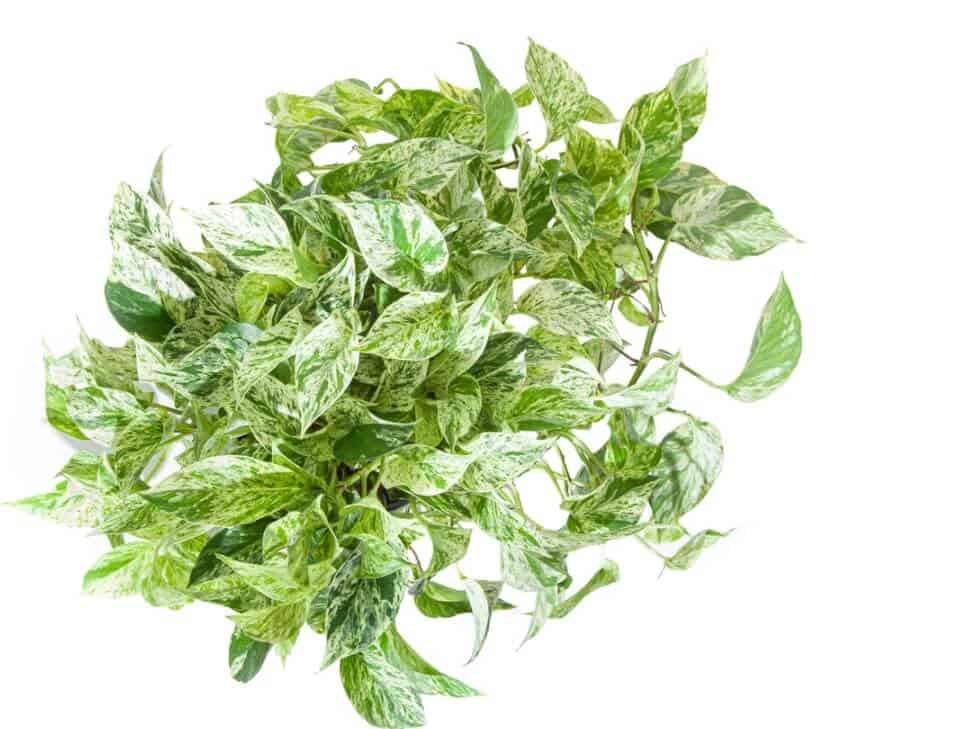
The Marble Queen Pothos is more evenly variegated. This means the ratio of white to green is 50% each.
You may buy a Marble Queen Pothos from this verified online seller who has positive reviews.
Price: USD 19.92 / € 16.37
Delivery: Within the USA: 4 to 5 days. Outside the USA: Please contact the seller to verify.
Comes With: Packed in a 2-inch pot. The plant will have 4 to 6 leaves before shipping.
How Much Light Does a Marble Queen Pothos Need?
The Marble Snow Queen Pothos is similar to most other Pothos plants and the Snow Queen Pothos regarding their light requirements.
It needs indirect light to grow well. One way to tell whether your Marble Queen Pothos is getting too little or too much light is to see the variegation on the leaves.
If the Snow Marble Queen Pothos becomes too white, it is not getting enough sunlight to contribute to the green pigmentation.
If it is getting too much light, the leaves will start turning brown.
Best Places to Buy the Snow Queen Pothos
You must be brimming with excitement to know about the Snow Queen Pothos for sale. Please refer to the list below of the best places to buy the Snow Queen Pothos.
Price: USD 37.15 / € 30.53
Delivery: To the USA: 10 to 15 days. Outside the USA: 10 to 15 days.
Comes With: The plant will have 6 to 8 leaves before shipping.
Price: USD 73.42 / € 60.34
Delivery: Within the USA: 4 to 5 days. Outside the USA: 10 to 15 days.
Comes With: Packed in an 8-inch pot. The plant will have 10 to 12 leaves before shipping.
The same seller also sells cuttings of the Snow Queen Pothos at a more affordable rate.
Price: USD 8.38 / € 6.89
Delivery: Within the USA: 4 to 5 days. Outside the USA: 10 to 15 days.
Comes With: Unrooted cutting that is attached to a stem and node.
Price: USD 20.97 / € 17.24
Delivery: Within the USA: 4 to 5 days. Outside the USA: Please contact the seller to verify.
Comes With: The plant will have 5 to 7 leaves before shipping.
Price: USD 23.05 / € 18.95
Delivery: Within the USA: 4 to 5 days. Outside the USA: Please contact the seller to verify.
Comes With: The plant will have 4 to 6 leaves before shipping. They are either 4 or 6 inches in size.
Price: USD 5.65 / € 4.65
Delivery: Within the USA: 4 to 5 days. Outside the USA: Please contact the seller to verify.
Comes With: Packed in a 4-inch pot. The plant will have 4 to 6 leaves before shipping.
Benefits of Snow Queen Pothos
The strongest reason why people want to grow a Snow Queen Pothos plant is that it is a brilliant air-purifier.
People also like this plant because it is so easy to grow and care for.
Other benefits of the amazing Snow Queen Pothos are:
- Removes unpleasant odour
- Increases Humidity
- Beautiful, especially when hanging from the walls or Trellis
- Strong absorber of Carbon Dioxide
- Reduces Stress
Common Problems
As wonderful as the Snow Queen Ivy is, you must be careful regarding the following issues:
1. Toxicity
It is extremely harmful if it has been ingested by both animals and humans. As such, you are strongly advised to hang this plant out of reach to both parties.
If ingested, it can cause skin irritation, burning feelings in your mouth, and tummy aches.
You must seek medical attention immediately for either pet or human if the plant has been ingested.
As the Snow Queen Pothos is a plant that can be hung or placed in a high environment, please consider that if you have either small children or pets at home.
2. Pests
Luckily for you, the Snow Queen Pothos is not easily disturbed by pests as it is strong and hardy. However, it can still be affected by certain pests.

Mealybugs look like fluffy, white cotton balls that stick themselves on the leaves of your plants. They also leave a sticky residue on your plant which is sweet.
Unfortunately, this will attract ants and other insects which will hurt your plant even more.
If left untreated, your Snow Queen Pothos will die.
If you find Mealybugs on your plant, please keep them away from other plants, so as not to infect the rest.
You can remove Mealybugs by spraying either organic Neem Oil or Organic Garden Spray. Either one of these will quickly kill the Mealybugs. Always remember to act quickly. If you let the infestation grow, your treatment will take longer and be harder.
We highly recommend you this 100% pure & organic Neem Oil from the brand Growel.
Scales are tiny insects that will crawl at the bottom of your leaves. It is red and they are harmful because they release honeydew on your plant, which is sweet.
Please do not think that this is the exotic fruit which you can consume. Honeydew in Botanical language refers to a colourless and sticky residue that is left behind on your plants.
It is sweet, thus it attracts other insects. Once you find a black, sooty coating on your leaves, the honeydew has sooty mould as well.
This is harmful because it will greatly damage your leaves and attract insects. The method of removing Scale is the same as Mealybugs.
You can remove Scale by spraying either organic Neem Oil or Organic Garden Spray. Either one of these will quickly kill the Scale infestation.
How to Save an Unhappy Snow Queen Pothos
Your Snow Pothos plant will communicate to you if it is dying. You may refer to the following signs and what you can do to resolve them.
Understanding the signs is crucial so that you can revive your plant properly.
1. Brown Leaves
Browning leaves are caused by too much direct sunlight or heavy overwatering. Direct sunlight will cause the leaves to turn yellow, and if left untreated, will eventually turn brown.
Overwatering causes brown leaves because the excess water in the soil will prevent nutrients from reaching the stems and leaves. This will eventually kill the leaves, causing them to brown.
You need to assess what it is that you are doing.
If your plant is under direct sunlight, please shift the location to somewhere with indirect light.
If you are overwatering, please check the moisture of your soil. Dip your fingers in up to 2 inches. If your finger feels moist, then do not water the plant.
2. Leggy Stems
If your Snow Queen Pothos has leggy stems, it means it is not getting enough sunlight. That is why the stems are growing tall with not many leaves. It is trying to reach out taller to get more light.
Please place your Snow Queen Pothos to be near indirect sunlight. The best measure is within 2 to 3 feet from a window that has sunlight.
3. Smelly
If our Snow Queen Pothos is suddenly emitting a foul odour, it is likely coming from your soil. The most likely cause is Root Rot.
If you have overwatered your Snow Queen Pothos or planted it in a pot that has no draining capabilities, it will eventually suffer Root Rot and become smelly.
The smell comes from the growth of bacteria in the water-laden soil. Please check how much you are watering by using the finger test. Alternatively, you can re-pot your Snow Queen Pothos in a well-draining pot or use well-draining soil.
If your Snow Queen Pothos has too many yellow leaves suddenly, it is because there is too much sunshine. It is starting to burn. Remember that a Snow Queen Pothos thrives in indirect sunlight, not under direct sunlight.
If the leaves on your Snow Queen Pothos are suddenly looking limp and sad, it is very likely due to dry soil or lack of humidity.
If your soil is very dry, it means you have not been watering it at all or very little. Remember that Snow Queen Pothos thrives in soil that is moist.
Alternatively, if your soil is moist but the leaves are still limp, it could be due to a lack of humidity. This is easily rectified by creating a pebble tray and placing your plant on it. The pebble tray will create humidity around your plant.
6. Root Rot
It was mentioned earlier that Root Rot is caused by overwatering your plant that is likely to be in a pot that is not draining well or has soil that is not draining well.
Another cause of Root Rot is when there is a fungal infection in your roots. It could be harmless if there is no water flooding the soil.
However, the moment there is overwatering, it could flare up the fungal infection, which damages the roots further.
You may address this issue by replanting your Snow Queen Pothos in fresh, well-draining soil. You should also trim away any damaged roots before replanting them.
This Indoor Potting Mix by Miracle-Gro has an easy-to-water formula that helps the soil easily re-wet while feeding for up to 6 months. Your plants definitely need it!
Damaged roots will look soft and brown. Healthy roots will look white and strong.
Varieties of Snow Queen Pothos
Interestingly, there is only 1 type of Snow Queen Pothos. However, there are about 22 varieties of Pothos plants.
Pothos plants generally share a similar care guide. Most of them are poisonous, easy to care for, and commonly used as houseplants.
The propagation steps for Pothos plants are generally similar too. If you wish to learn more about the specific Pothos plants, please refer to the list below.
The most common are:
- Snow Queen Pothos
- Golden Pothos
- Jade Pothos
- Marble Queen Pothos
- Neon Pothos
- Manjula Pothos
- Pearls Pothos
- Glacier Pothos
- Cebu Blue Pothos
- Hawaiian Pothos
- Jessenia Pothos
- Satin Pothos
Conclusion
There you have it, folks. Your most comprehensive guide to caring for Snow Queen Pothos with all the best places to buy them. As a bonus, you have also learned a bit about the Marble Queen Pothos and the other varieties of Pothos plants.
If you are a beginner in caring for houseplants, then you should start with the Snow Queen Pothos.
The ease of caring for this will be a huge confidence booster for you as you slowly move on to more challenging plants.
Good luck in your botanical journey and thank you for reading this article.







